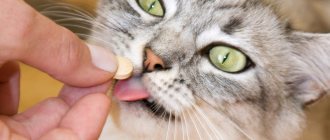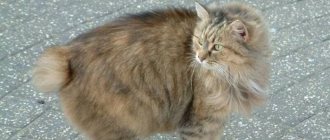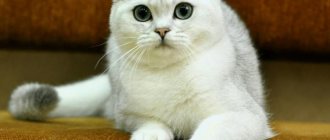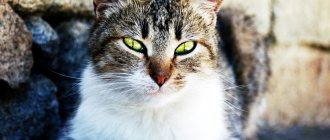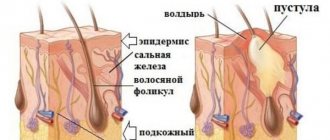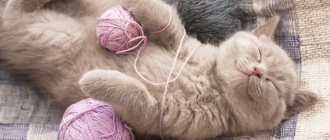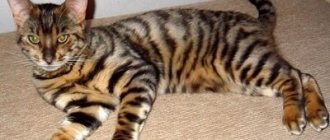Creodont cat's ancestors
This is the official version of the origin of the cat. Scientists believe that the first cats were evil creodonts. They ate meat, cruelly dealing with their next prey, and were much larger in size than the tiger we know, and even more so than the beloved domestic cat. All scientists adhere to this version, although they do not have direct evidence of it. When children ask where cats came from, they are often told this version.
Creodonts inhabited the vastness of the Earth fifty million years ago. These were dangerous predators that terrified all representatives of the fauna. Everything that moved, ran away, and chewed was eaten.
Many years later, thanks to evolution and amazing transformations, the first lions, saber-toothed tigers, and cheetahs appeared. And after thousands of years, we were able to see a cat that we can take home with pleasure and without fear. But this is too simple an answer to the question of where domestic cats came from. Let's look into mythology?
The connection between the domestic cat and its “wild relatives”
Cats can be domestic or wild. The wild cat family includes 37 species; they are considered the most advanced predators of all land animals. These include the puma (America), jaguar (Central and South America), lion (Africa), tiger (Asia), cheetah (Africa and western Asia), snow leopard (Himalayas), lynx (Europe) and others. Large representatives can be dangerous even to humans.
People started breeding new breeds of domestic cats relatively recently - about 150 years ago. There are now more than 100 cat breeds. Among them, the most famous long-haired ones are Persian and Maine Coons; shorthaired - Siamese, British; hairless cats - sphinxes and others.
But so far there are much fewer purebred cats than the usual and beloved “Murok” and “Vasek”. Felines belong to the family of mammals, the order of carnivores. All types of cats have a small head, and a very slender, graceful body. The legs are not high, but powerful. The claws are fully or partially retractable, only the cheetah cannot retract. Most have a long tail, but the lynx has a short tail.
The sizes of cats range from small (20 cm at the withers, for example, domestic cats) to large (120 cm - tiger, lion). The best developed sense organs are hearing and vision. The lifestyle is largely nocturnal and twilight. Food includes fish, birds, reptiles, mammals, and sometimes insects. Most species hunt alone (cheetahs, tigers) or as a whole brood (lions in a pride).
Scientists have found that the tiger and the domestic cat are closest relatives; their common ancestor lived on earth about 11 million years ago. For comparison, the common ancestor of humans and apes lived approximately 12 million years ago. Scientists have concluded that “Tigers are just big domestic cats...” since the differences between the genomes of a tiger and a cat are only 4.4%.
Video
Noah's Ark didn't carry cats.
Everyone knows about the purpose of the legendary Noah's Ark. This huge ship became a salvation for all types of animals. Only there were no cats then, and therefore they were not on Noah’s ark. As the legend says, during the long voyage, animal excrement began to greatly interfere with normal existence.
Mice and rats multiplied at such a speed that food supplies might not be enough until the end of the voyage, since the rodents ate everything. People and animals were threatened with terrible starvation, and God himself again came to the rescue. He told Noah to stroke the elephant's trunk, and at the same moment a pig appeared from the trunk, it destroyed all the fetid excrement. Then Noah, again on the advice of the Almighty, stroked the lion's nose, and a cat appeared from it. It was she who saved the inhabitants of the ark by catching all the mice.
Buddhist interpretation
Where did all the superstitions about black cats come from and are they true?
Buddhism is not as kind to these pets as Egyptian culture, but in general, every animal is important to them, and cats are no exception. The appearance of a cat is interpreted as another subspecies of a lion or as a possible rebirth (reincarnation) of the human soul in the guise of a new beast. At first, cats were not particularly revered in the culture due to one legend in which these animals disrespected the Buddha, but then they were recognized on an equal basis with others.
For your information! In Buddhism, it is believed that cats, like people, can achieve the most desired and blessed state - nirvana, and all thanks to their calmness and tranquility.
The cat is revered in Buddhism, like other animals.
Cats came from the cat planet
I would like to believe in the unearthly origin of cats. The first images of these creatures appeared in Egypt, and there is a myth that it was in Egypt that the first cat aliens arrived. They were completely bald and could communicate with people with the power of thought.
As the legend says, one of the cats wandered into the forest and met there an ordinary and shaggy steppe cat. They fell in love with each other, and the bald cat refused to leave the Earth, she chose love. The couple was happy throughout their cat life, and they produced furry offspring that became the ancestors of today's domestic cats.
History of cats: from antiquity to the present day
The history of the existence of cats on the planet begins long before the evolution of humanity. And the domestication of the cat family dates back to long before our era. Primary sources claim that the first who trained a cat and placed it next to them were the Egyptians.
This happened back in the 16th century BC, or more precisely, in 1600. Although there is another version of domestication: in Nubia, the North African steppe cat was tamed and trained. It is this version that has taken root more in Russia.
From 950 to this day, the cat in Egypt is considered a deity
.
A temple with the head of a cat was built in her honor, and celebrations were held in it every year in her honor. More than half a million parishioners could gather in the temple. The priests got themselves these wayward pets and indulged their desires in every possible way, and upon death, the cat was mummified and buried in separate tombs, seeing off with honors. The cat’s first name was also given in Egypt
, the owner called her
Nej
, translated into Russian as “
darling
”.
The spread of cats throughout the world occurred thanks to sailors who took them with them on long wanderings across the sea.
in different countries. In England in 948, by law, a kitten was given one penny, but if it caught at least one rodent, its price rose to 2 pesos.
In Russia, the cat took root in the 11th century, without it they did not build a house and did not enter the hut, the cat in Russia was considered a good animal
, which drives away evil spirits around. Over all the centuries of the existence of cats next to humans, many revolutions associated with them have occurred; they were either elevated to a pedestal of honor and deified, or were mercilessly persecuted or burned.
Today, there are cats in almost every home, and there are a great many breeds of them. more than 50 species of cats around the world
for domestication, in addition, thanks to the crossing of different breeds of subspecies, twice as many.
The most common breeds
Today, cats are considered to be Russian Blue, Cornish Rex, Exotic, Siamese, Sphynx, Scottish Fold, Maine Coon, British, Persian, Kuril Bobtail. The rarest cat breeds are Domestic Serval, Elf, Serengeti, Monchikins, Toyger.
Over the course of its life, a domestic cat can give birth to up to 200 kittens. The largest litter was that of a cat from the USA - 19 kittens, 4 of which were stillborn. Of the survivors, 14 were males and 1 female.
To the Guinness Book of Records
There was a cat from Britain who lived for 34 years. They say that in order for a cat to live longer, it should live with older people and endure less stress and anxiety.
Take care of your cats and they will take care of you!
Cats are born from the sun god
Peering into the piercing and deep eyes of the purr, the question naturally arises in your head about where cats came from. These graceful creatures seem to be mystical creatures sent to us by the Creator himself.
According to the wisest pharaoh Akhenaten, he was the son of the sun god and his half-brothers and sisters were cats. Only he was born in human form. It’s not for nothing that our pets’ bodies are filled with such warmth that can cure all human ailments. Does it seem fantastic? But Pythagoras, one of the smartest people of antiquity, did not think so. He adhered to the opinion of Akhenaten and had already built his hypothesis of the extraterrestrial origin of cats when his life expired. He died without proving to people that cats are real deities. Everyone ridiculed Pythagoras and did not believe him, but this man made a huge contribution to science.
Modern cat breeds
Eye color, coat color and length, body structure, head and tail, character - all these characteristics are taken into account when creating the breed. The World Cat Federation (WCF) adheres to the following classification of cat breeds:
- long-haired;
- with medium length hair (semi-longhair);
- short-haired;
- Shorthaired Siamese-Oriental.
The International Organization for the Breeding and Selection of New Breeds of Cats (FIFe) uses a slightly different classification:
- exotics and Persians;
- semi-longhaired;
- shorthaired, including Somalia;
- eastern (orientals).
The concept of a “breed” of cats appeared not so long ago. Even 200 years ago, these pets were not classified according to breed characteristics.
It is customary to refer to purebred pets as having certain external characteristics and a unique character.
With the development of breeding work, animals of a certain breed began to be issued documents confirming their belonging and compliance with the standards of this breed. Pets obtained as a result of crossing purebred parents can obtain a pedigree. The document indicates not only parents, but also other ancestors (up to the 4th generation).
There are very few purebred cats all over the world (about 3%), all other pets are classified as mongrel, but this makes them no less revered by humans. Only individuals who do not have breed defects are allowed to participate in exhibitions according to the show class. But individuals without a pedigree are allowed to be shown only in the pet category.
Messengers from distant stars
No matter how funny it may seem, there are many great minds who are completely sure that cats literally fell to Earth from the Moon!
Plotinus (Neoplatonist philosopher) was even able to argue his opinion about the origin of cats. He wrote in the Ennead irrefutable evidence specifically in favor of the Moon. In his opinion, cats are creatures of this satellite because they see well in the dark, are active at night, and their behavior depends on the phases of the moon.
According to Augustine the Blessed, who wrote the work “On the City of God,” cats are sent to us from those very distant stars where the human soul resides after death. The Almighty only showed them the way there and back, and they can communicate with spirits. But it’s not for nothing that people are sure that cats get along well with ghosts and see them, which is not given to humans.
Stories of the appearance of purebred cats
Cat breeds appeared thanks to the selective work of people, but certain species arose due to gene mutations. There are also native breeds of pets, that is, those that appeared in isolated areas, they are classified as naturally formed breeds:
- Siberian;
- Angora;
- Thai.
Some breeds are hybrid. They arose as a result of the mating of wild and domestic individuals. The Bengal cat is usually classified as a hybrid cat; Asian leopard wild cats and domesticated pets participated in the creation of the breed.
NASA says aliens look like cats
Perhaps it was not for nothing that in the Middle Ages people believed that the cat was an unearthly creation. Not long ago, everyone was stunned by the news about the discovery of American astronauts. The guys landed on the moon and found many unusual objects there. They resembled small coins in size. Having brought the artifacts with them, the astronauts sent them to the laboratory. The result of the analysis simply shocked everyone: a similar composition exists on Earth, this is cat feces. Well, tell me, where did they come from on the Moon?
Since then, NASA scientists began to develop the hypothesis that cats are real aliens and all aliens look exactly like this!
How did the cat family appear?
Scientists believe that all mammals on Earth descended from ancient creodonts. This group arose more than seventy million years ago and included predators, scavengers, and omnivores.
Twenty million years later, a branch of miacids emerged from the creodonts. These are predators with higher intelligence, flexible and long bodies and tails, and short legs.
About forty million years ago, evolution split this group into two. From one came the canid class and modern dogs. The second is the predecessors of modern viverrids, and those, in turn, are the progenitors of the feline species.
The unique Fossa, currently living only on the island of Madagascar, according to biologists, is the only surviving ancient form close to the first civets. In appearance, this small animal resembles both a cat and a mongoose. For a long time it was classified as a cat.
The next stage of development is Proailurus - a nimble, swift, flexible and tough hunter living in trees. Modern cat species have changed little in appearance. The paws became longer, the brain size increased, and the muzzle became shorter.
From Prolaurus came Pseudelurus, the ancestors of the extinct saber-toothed tiger and all modern species of large, medium and small cats.
The closest to modern species are Asian linsangs, which today are not considered viverrids, but are classified as a separate family.
According to research by geneticists, the domestic cat Felis Catus on the maternal side is descended from five species of the subspecies of the Steppe cat Felis silvestris lybica. This subspecies originated 130,000 years ago and is still very common across North Africa and from the Mediterranean to China.
Of the large wild animals, the lynx is considered the most ancient - this animal appeared on the planet four million years ago. Next come the puma, leopard and lion. These species arose three, two million and seven hundred thousand years ago, respectively.
Wild Middle Ages
I would like to take a little break from thinking about where cats came from and talk about their role in human life. Now these animals are not in danger, but just recently cats were subjected to terrible torture and executions. People believed that purrs were assistants to witches and the devil himself and burned them at the stake.
There was another, no less terrible, killing of cats. During the Middle Ages, once a year a holiday was held in the city of Ipern, it was called “Cat Day”. For the cats themselves, this day did not bode well; they were thrown in huge quantities from the highest towers.
In the 18th century, a bishop from Germany ordered all cats to have their ears and tails cut off, while at the same time the kings of France had fun watching purring cats suffer at the stake.
A nightmare, and that's all. Only in Egypt were cats deified, cared for during their lifetime, and all representatives of the tailed family lived in luxury. After death, cats were mummified and buried next to the pharaohs.
In Russia, from the very beginning, this beast was not considered by people to be either a god or a devil; it was kept for catching mice and rats. By the way, where did cats come from in Russia?
How and when the cat was tamed
The question of dating the domestication of cats has long been of interest to scientists. Most of them agree that this happened simultaneously with the development of animal husbandry and agriculture. People no longer had to spend whole days getting food; moreover, there was a surplus of food. The problem of ensuring their safety immediately arose: food warehouses became places of pilgrimage for rodents, which not only completely destroyed supplies, dooming people to starvation, but also spread diseases that decimated the population of villages and cities.
Cats that came to human homes and hunted rodents became a real salvation. There is only one problem left to solve: to ensure that cats live with people permanently. This was not easy to do due to the freedom-loving nature of these animals, therefore, according to one version, people tracked down wild cats, took their offspring and tried to tame the kittens.
According to another version, great credit for the domestication of cats belongs to the ancient Egyptians, who not only treated these animals kindly, but also deified them. The status of a cat in Ancient Egypt was hardly lower than the status of the pharaohs themselves; it was impossible to imagine not only killing an animal, but also causing the slightest harm to it. Such actions were punishable by death. Cats lived at temples and in the houses of the nobility, after death the animals were mummified and buried with great honors, the owners shaved off their eyebrows as a sign of grief, and mourning for a pet lasted the same amount as for a person - 70 days.
In China, cats lived next to humans more than five thousand years ago. This was confirmed by radiocarbon dating of animal remains discovered at the archaeological site of the village of Kuahukun. Cats were loved and revered in China no less than in Egypt. These animals were valued not only for their hunting qualities, but also for their loyalty.
In Europe, attitudes towards cats were not so unequivocally positive. In Ancient Greece and Ancient Rome, these animals were loved, although they were not deified, as in Egypt. In other European countries, cats are much less fortunate. At first they were considered valuable animals. In England in the 10th century. a mouse cat was more expensive than a lamb, and the rules for keeping these animals were regulated by royal decree. The ancient Scandinavians believed that cats belonged to Freya, the goddess of love and fertility, and the priestesses of the goddess had the right to put to death anyone who harmed a cat.
In the Middle Ages, attitudes towards cats changed radically. If previously mysterious and mystical properties were simply attributed to them, now these animals were declared by the Church to be accomplices of the devil. Black cats were especially unlucky; they were considered the embodiment of evil and they believed that witches could turn into them. Cats began to be exterminated en masse, inventing the most sophisticated methods of killing, and those who continued to love the unfortunate animals and kept them at home were tortured and burned at the stake as sorcerers. As a result of the actions of the Inquisition in Europe, 90% of the cat population was destroyed, for which people soon paid dearly. The rats that bred in huge numbers and the fleas that lived on them contributed to the outbreak of the bubonic plague epidemic, from which, according to various estimates, from a quarter to half of the population of Europe died in the 14th century.
Only in the 17th century. superstitions towards cats began to fade into the background, and these animals again began to win the respect and love of people.
People of royal blood did not hesitate to keep cats at court; they were pampered and cared for in every possible way and were even given fortunes. Around the same time, work began on creating new breeds.
In Rus', cats were never subjected to such persecution as in Europe; moreover, it was believed that they bring happiness and prosperity; it was not for nothing that when entering a new house, the cat was the first to be allowed into it. These animals are the only ones allowed to be in Orthodox churches; in many old churches they even had manholes made for them.
For a long time in Rus', cats were very expensive, so not everyone could afford them. In Kazan, it was customary to place the most well-groomed cats in the windows of merchant shops: the fatness of the animal was supposed to show that its owner was doing well. It was Kazan cats that were brought by decree of Empress Elizaveta Petrovna to St. Petersburg to protect the chambers from mice and rats. Their descendants are still in the service of the Hermitage and protect the museum property from rodents.
The appearance of cats in Rus'
Excavations carried out in Russia and the former Soviet Union have shown that cats appeared on our lands in the seventh century. But the first descriptions of these animals are in documents dating back to the eleventh century. It is assumed that foreign sailors brought strange animals to Russia and sold them for huge sums of money. People liked this creature, because its eyes glow in the dark, and from any height it falls on all four paws, and even purrs!
Over time, the cats began to breed and multiply, and now in the peasant huts the beast caught mice and rats, protecting the owner's supplies.
There is a legend that Peter the Great himself adored these creatures and, seeing how another cook was chasing a fluffy one, declared cats to be inviolable creatures. You may ask, why does a chef need a cat? This animal simply brought him a dead rat as proof of its work and irreplaceability and placed it on the cutting table. That's all. But since then no one could offend the tailed one in Rus'.
Theory of the origin of cats
Cats belong to the carnivorous mammals of the cat family. According to scientists, approximately 600 million individuals have been domesticated in the modern world. The history of modern cats is closely connected with forest and steppe representatives of the cat family. The term cat itself comes from the Latin “cattus”; in the Old Russian language there was a name “kotka”.
There are two versions about the origin of cats. According to one of the biblical legends, rodents appeared on Noah’s Ark during the Flood, which other animals could not cope with. Then the lions gave birth to cats, which, thanks to their small size and dexterity, were able to catch all the rats and mice.
According to the second version, the first wild cats inhabited the planet more than 60 thousand years ago. The ancestor of the cat family is considered to be the Fossu, an ancient species that lived in Madagascar. There is another scientific opinion that has a right to exist - the ancestor of modern seals was Proailurus, which existed approximately 25 million years ago on the territory of Eurasia.
The weight of Proailurus was about 9 kg, the animal had a dense build, short limbs and an elongated body with a long tail. Sharp, half-retractable claws made it possible to spend most of the time not on the ground, but in trees. This way of life helped to escape from large predators.
It is believed that many lineages of cats, including saber-tooths, originated from Proailurus. He was the progenitor of a suborder including hyenas, civets and cats of prey.
Where did Siamese cats come from?
The Siamese cat, which many associate with a demon, originated in Thailand between 1350 and 1750. This is a purebred animal, and man made no effort to breed the breed.
The first Siamese are described in writings from the 19th century. It says that these cats were considered sacred animals and were kept in Buddhist temples. Only priests and royal families were allowed to have them.
Today everyone can afford this breed of pet; they are bred in nurseries.
The history of unusual cats: treasures of the world
Anyone who is interested in such a question as the history of unusual cats receives, first of all, information about unusual breeds that were specially bred or appeared as a result of mutations. However, the history of unusual breeds is not all, because the originality of a cat can be determined by both its character and its extraordinary destiny. And the world knew a lot of examples of the lives of such pets.
As a rule, the history of unusual cats begins with their unique abilities. There are telepathic cats, cats that find their home a million kilometers away, cats that are heirs to huge fortunes, and even talking cats. The memory of each of these animals is preserved in history for centuries.
Read more
Where did Sphynx cats come from?
In fact, there are a huge number of sphinx breeds and not all are popular. Where did hairless cats come from? This question torments many people. Descriptions of hairless cats have been available since ancient times; the Aztecs could have been their owners.
At all times, hairless kittens have been born on the territory of our planet. They were of no interest to people and were simply destroyed. A resident of Canada was the first to decide to breed the breed when, in 1966, he discovered a hairless cat in his cat’s litter. The baby was named Prunt and later brought together with his mother. Both normal and hairless kittens were born again. Then hairless cats and female cats were bred until shaggy creatures completely disappeared from the litters. This is how the now popular sphinxes appeared, and they owe their origin to an ordinary mutation.
What if the legend is true, and once upon a time hairless alien cats visited our Earth, and now cats give birth to hairless kittens, reminding them of their origin? This will forever remain a secret!
Cat as an attraction
Ekaterina Kachura-Falileeva.
At the samovar. 1st half XX century Cats still “work” in the Hermitage - not in the exhibition halls, but in the courtyards and basements. Each cat has a veterinary passport, a bowl and a basket for sleeping. In 2021, the British publication The Telegraph included the Hermitage cats in the list of unusual attractions that you must see if you come to St. Petersburg.
“There are only 50 cats, I set this limit myself. They live in the yard and in basements. We give “extra” cats to good hands. They know their habitats in the basements; there is no need to guide them. We have interviews and filming about cats no less often than about Rembrandt.”
Director of the Hermitage Mikhail Piotrovsky, Literaturnaya Gazeta, 2014
